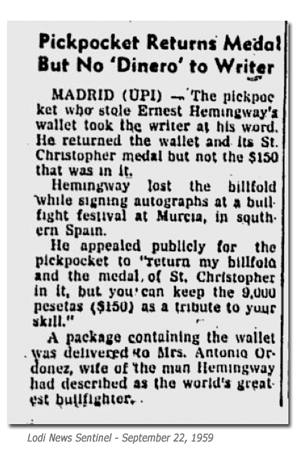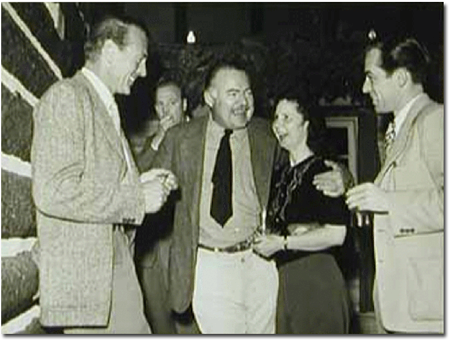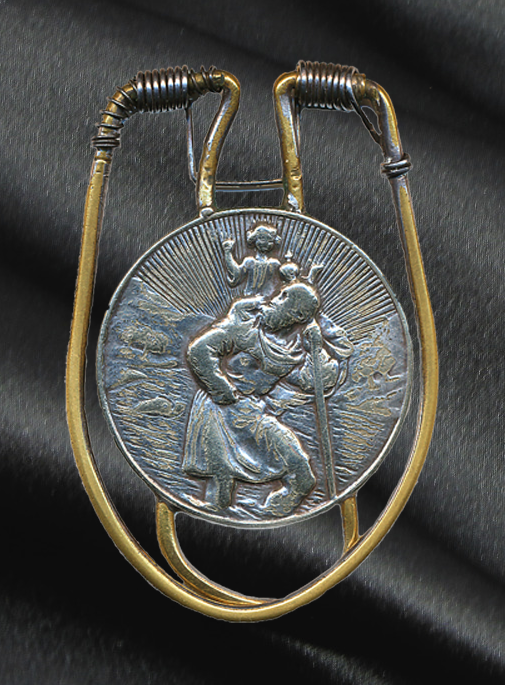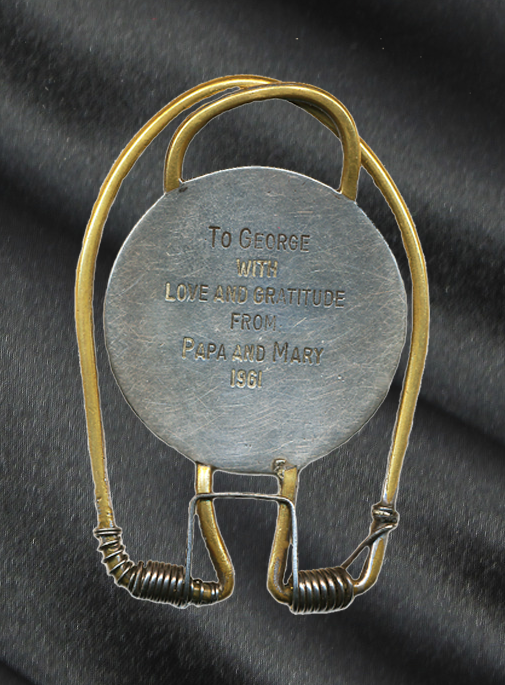Ernest Hemingway
Ernest Hemingway
St. Christopher Money Clip - 1961
Of the more distinguished items we have ever offered, few have come to us with such a significant historical pedigree and an impeccable provenance: Ernest Hemingway’s St. Christopher Medal that he carried with him up until the last months of his life, when he presented it to his best friend and personal physician, Dr. George Saviers, not long before committing suicide. Inscribed on reverse “To George with Love and Gratitude from Papa and Mary 1961.” The medal itself has a 1.5″ circumference, and the entire clip is 2 3/4″ long.
According to his friend and biographer A.E. Hotchner, Hemingway—one of literature’s most prominent atheists—was fond of good luck charms and carried numerous talismans throughout his life: a German belt buckle appropriated from a dead Nazi; a rabbit’s foot; horse chestnuts he found in Paris; a piece of shrapnel removed from his leg in World War I—and his cherished St. Christopher medal. It is unknown, but certainly likely, that Hemingway carried this with him during his reportage of the Spanish Civil War and World War I, as well as World War II.
It was obviously of significant importance to him. In September 1959 Hemingway’s pocket was picked for the third time in Spain, as he was signing autographs in Murcia while researching a series of bullfighting articles for Life Magazine. In a newspaper advertisement the next day, he sportingly appealed to the thief to return the wallet and the St. Christopher medal, but to keep the cash it contained as a tribute to the technical skill. The pickpocket accommodated Hemingway’s plea, returning the wallet and the medal in a package delivered to the author’s renowned friend, the famed bullfighter Antonio Ordonez. And, obligingly, the money was gone:

As you can see in the images, Hemingway had the St. Christopher medal fashioned into a crude but functional money clip, likely crafted by a Cuban artisan while at his Finca Vigia farm on the outskirts of Havana. Though still remarkably detailed given its age, the faces of the figures are somewhat worn from years of use, but the clear inscription on the back speaks to Hemingway’s fondness for the man who counseled him through two previous attempts at suicide; who monitored his high blood pressure daily in Ketchum, Idaho; and who ultimately served as one of the pallbearers when the great writer died.
This extraordinary Hemingway artifact is truly a one-of-a-kind treasure, accompanied by a rock solid provenance from the estate of George Saviers, the “country doctor” widely known as an intimate friend and hunting companion of Ernest Hemingway during the last years of his life.

Gary Cooper, Hemingway, Tillie Arnold & Dr. George Saviers—Sun Valley 1948
Courtesy the Estate of George Saviers
In the fall of 1960 Hemingway was admitted to the Mayo Clinic in Minnesota, ostensibly for treatment of high blood pressure but in reality for a more robust treatment of the severe depression that his wife Mary could no longer handle on her own. To avoid publicity, he was registered under the name “George Saviers.” Tragically, his treatment at the Mayo Clinic would ultimately lead to electroshock therapy, resulting in loss of memory, a devastating outcome for Hemingway. Without his memory he could no longer write, could no longer recall essential facts and images. Writing, which had already become difficult while dealing with depression, was now nearly impossible. Less than a year later, Hemingway took his own life—within six months of giving this very St. Christopher medal to his friend George Saviers.


